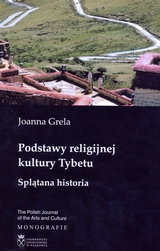
Joanna Grela, Foundations of the Religious Culture of Tibet. Entangled History [Podstawy religijnej kultury Tybetu. Splątana historia], Wydawnictwo Nowa Strona, Kraków, Bielsko-Biała 2015.
Although Buddhism has had a great impact on the culture of Tibet, the author argues that at the basis of the Tibetan religious culture, both ancient and manifested today, lie various, hardly researched folk and pre-Buddhist concepts and practices. While assimilating in Tibet, Buddhism did not eliminate attitudes and behaviours contradictory to its normative system, such as divination practices, rituals bringing auspiciousness, calling the soul or local folk worship, but did the opposite and absorbed as well as adapted to them. The book highlights and examines recurrent narrations, important mythic themes and key ideas as regards the universe and man, such as rainbow light and specific understanding of the soul, forming the concept base for these practices. The author shows their interconnections and overlapping, stressing the centuries-old transculturality of the examined area, pluralism of the ideas and practices found on the Tibetan Upland (such as the ones connected to the earliest beginnings or to worship of the mountains), stemming from the actors’ mobility, frequent contacts and mutual influences between the nomadic peoples, merchants, pilgrims, travellers and neighbouring settled peoples.
Table of Contents
Notes on spelling and pronunciation
List of abbreviations
Introduction
Chapter one: Basic groups of Tibetan beliefs
1.1 Folk religion
1.2 Bon
1.2.1 Discussion on etymology and semantics
1.2.2 Research status
1.2.3 Historical outline
1.3 Buddhism in Tibet
1.3.1 Research status
1.3.2 The beginnings of Buddhism in Tibet – religious and political transformations of the history
Chapter two: Myths and mythologems
2.1 Tibetan origin myths
2.1.1 Monistic cosmogonies
2.1.2 Dualistic cosmogonies
2.1.3 Anthropogenic myths
2.2 Rainbow mythologem
2.3 Cultural heroes
2.3.1 Mythical rulers
2.3.2 King Gesar as the Tibetan hero ethos
2.3.3 Mythological religious specialists – civilizing heroes
Chapter three: Main ideas, their representations and selected cultural practices
3.1 Vertical three-part world structure and the mountain worship
3.1.1 Folk worship connected to the mountains
3.1.2 Pilgrimages and the practices of circumambulation
3.1.2.1 Examples of mountains
3.1.2.2 Examples of lakes
3.2 Multitude of invisible beings. The concept of pollution
3.3 Selected rituals and methods of dealing with spirits
3.4 Tibetan view of the soul
Conclusion
Annexe 1
Bsang ritual
Annexe 2
Photographs
Bibliography
Name index
Subject index
Summary

